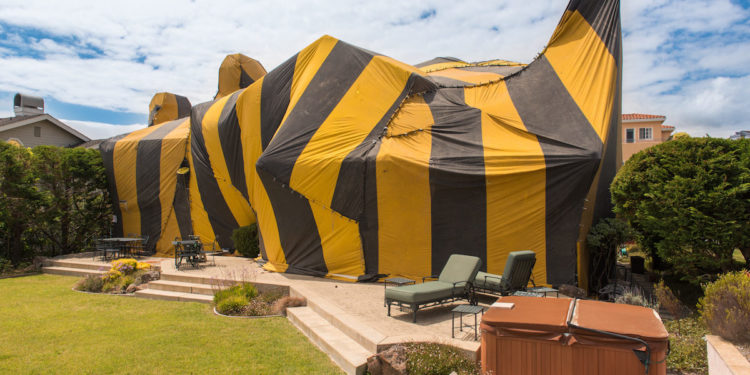
Fumigation as a Whole Structure Treatment
Fumigation method as a whole-structure treatment can only be done by an experienced pest control professionals. Fumigation is the process where insects are eliminated from a structure with the use of lethal gas. Fumigation agents are carried out using essentially one chemical: Sulfuryl Fluoride. This gas is odorless, colorless and leaves no residue. Therefore, prior to the fumigation, applicators introduce trace amounts of Chloropicrin. Chloropicrin (a warning agent) has a strong odor and will cause respiratory and eye irritation.
Termite fumigation takes approximately 3 days while a tent is placed over your home. A tarpaulin (tent) is placed over your home and sealed off. Once sealed off, a fumigant is released inside, killing all the termites. This whole house solution is the most effective method against drywood termites colonies in your home.
Fumigation Preparation
Items to be addressed in preparation for the fumigation of the average home are:
- All people, pets, (including fish and/or fish tanks), and plants must be removed from the home. If it’s living, take it out!
- All food and medicines should be removed or sealed in special bags (your contractor will inform you about these fume-bags) according to the instructions from the fumigator.
- Outside plants close to the structure should be cut back from the house to allow workers access to the walls of the building. The perimeter of the structure should be heavily watered to help prevent the fumigant from moving into the soil and affecting the plants.
- Antennas, chimney caps, and weather vanes should be removed.
- Fences without gates attached to the house may need to have some boards removed to allow the tarps to reach the ground.
- Remove mattresses (except waterbeds) and pillows which are completely enveloped in waterproof covers or remove covers. All mattresses encased in permanent, waterproof coverings must be removed from the structure prior to the introduction of the fumigant, including infant mattresses.
Fumigation period
Sulfuryl Fluoride is usually held in the structure for approximately 16-30 hours. Fumigation time is dependent upon the factors mentioned previously. The fumigator aerates the structure with use of fans and inlet devices for a minimum of 12 hours.
Re-entering the structure
A structure must be certified safe for re-entry by the licensee in charge of the fumigation. To ensure that even the owner or tenant cannot re-enter a structure, the company is required to place a secondary lock on all outside doors that only the company can open.
Certification is the final step of the fumigation. The fumigator must aerate a structure, so that the concentration of gas in the air is one (1) part per million (ppm) or less prior to allowing re-entry.
The fumigator is required to post a re-entry notice on the property at the time the structure is actually deemed safe for occupancy. If within 24 hours following aeration, you experience headaches, dizziness, nausea, tearing, coughing, nose or throat irritation, shortness of breath, double vision, unusual drowsiness, or tremors:
Leave the fumigated structure and get to fresh air. Immediately contact your physician. Let the fumigation company know what happened, and call your local agricultural commissioner to report the incident.
